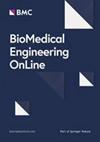Automatic localization of cochlear implant electrodes using cone beam computed tomography images
IF 2.9
4区 医学
Q3 ENGINEERING, BIOMEDICAL
引用次数: 0
Abstract
Cochlear implants (CI) are implantable medical devices that enable the perception of sounds and the understanding of speech by electrically stimulating the auditory nerve in case of inner ear damage. The stimulation takes place via an array of electrodes surgically inserted in the cochlea. After CI implantation, cone beam computed tomography (CBCT) is used to evaluate the position of the electrodes. Moreover, CBCT is used in research studies to investigate the relationship between the position of the electrodes and the hearing outcome of CI user. In clinical routine, the estimation of the position of the CI electrodes is done manually, which is very time-consuming. The aim of this study was to optimize procedures of automatic electrode localization from CBCT data following CI implantation. For this, we analyzed the performance of automatic electrode localization for 150 CBCT data sets of 10 different types of electrode arrays. Our own implementation of the method by Noble and Dawant (Lecture notes in computer science (Including subseries lecture notes in artificial intelligence and lecture notes in bioinformatics), Springer, pp 152–159, 2015. https://doi.org/10.1007/978-3-319-24571-3_19 ) for automated electrode localization served as a benchmark for evaluation. Differences in the detection rate and the localization accuracy across types of electrode arrays were evaluated and errors were classified. Based on this analysis, we developed a strategy to optimize procedures of automatic electrode localization. It was shown that particularly distantly spaced electrodes in combination with a deep insertion can lead to apical–basal confusions in the localization procedure. This confusion prevents electrodes from being detected or assigned correctly, leading to a deterioration in localization accuracy. We propose an extended cost function for automatic electrode localization methods that prevents double detection of electrodes to avoid apical–basal confusions. This significantly increased the detection rate by 11.15 percent points and improved the overall localization accuracy by 0.53 mm (1.75 voxels). In comparison to other methods, our proposed cost function does not require any prior knowledge about the individual cochlea anatomy.利用锥束计算机断层扫描图像自动定位人工耳蜗电极
人工耳蜗(CI)是一种植入式医疗设备,可在内耳受损的情况下通过电刺激听觉神经来感知声音和理解语音。刺激是通过手术将电极阵列植入耳蜗进行的。CI 植入后,锥形束计算机断层扫描(CBCT)用于评估电极的位置。此外,锥形束计算机断层扫描还用于研究电极位置与 CI 用户听力结果之间的关系。在临床日常工作中,CI 电极位置的估算需要人工完成,非常耗时。本研究旨在优化 CI 植入后根据 CBCT 数据自动定位电极的程序。为此,我们分析了 10 种不同类型电极阵列的 150 组 CBCT 数据的自动电极定位性能。我们对 Noble 和 Dawant(《计算机科学讲座笔记》(包括《人工智能讲座笔记》和《生物信息学讲座笔记》分册),施普林格,第 152-159 页,2015 年。https://doi.org/10.1007/978-3-319-24571-3_19)的自动电极定位方法的实现作为评估基准。我们评估了不同类型电极阵列在检测率和定位精度上的差异,并对错误进行了分类。在此分析基础上,我们制定了优化自动电极定位程序的策略。结果表明,电极间距过远,加上插入过深,会导致定位过程中出现心尖-心底混淆。这种混淆会妨碍电极的正确检测或分配,导致定位精度下降。我们为自动电极定位方法提出了一种扩展成本函数,可防止电极的重复检测,从而避免心尖-基底混淆。这将检测率大幅提高了 11.15 个百分点,并将整体定位精度提高了 0.53 毫米(1.75 个体素)。与其他方法相比,我们提出的成本函数不需要任何有关耳蜗解剖的先验知识。
本文章由计算机程序翻译,如有差异,请以英文原文为准。
求助全文
约1分钟内获得全文
求助全文
来源期刊

BioMedical Engineering OnLine
工程技术-工程:生物医学
CiteScore
6.70
自引率
2.60%
发文量
79
审稿时长
1 months
期刊介绍:
BioMedical Engineering OnLine is an open access, peer-reviewed journal that is dedicated to publishing research in all areas of biomedical engineering.
BioMedical Engineering OnLine is aimed at readers and authors throughout the world, with an interest in using tools of the physical and data sciences and techniques in engineering to understand and solve problems in the biological and medical sciences. Topical areas include, but are not limited to:
Bioinformatics-
Bioinstrumentation-
Biomechanics-
Biomedical Devices & Instrumentation-
Biomedical Signal Processing-
Healthcare Information Systems-
Human Dynamics-
Neural Engineering-
Rehabilitation Engineering-
Biomaterials-
Biomedical Imaging & Image Processing-
BioMEMS and On-Chip Devices-
Bio-Micro/Nano Technologies-
Biomolecular Engineering-
Biosensors-
Cardiovascular Systems Engineering-
Cellular Engineering-
Clinical Engineering-
Computational Biology-
Drug Delivery Technologies-
Modeling Methodologies-
Nanomaterials and Nanotechnology in Biomedicine-
Respiratory Systems Engineering-
Robotics in Medicine-
Systems and Synthetic Biology-
Systems Biology-
Telemedicine/Smartphone Applications in Medicine-
Therapeutic Systems, Devices and Technologies-
Tissue Engineering
 求助内容:
求助内容: 应助结果提醒方式:
应助结果提醒方式:


